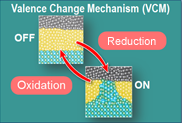The valence change effect (VC) has been specifically observed in transition metal oxides and related materials. Triggered by a forming process, the switching effect involves a local electrochemical redox reaction and is conducted by a migration of ions, such as anion vacancies, along extended defects which seem to act as conductive filaments. A subsequent change of the stoichiometry, and a valence change of the cation sublattice leads to a resistance change at the electrode interface. The direction of the memory switching is determined by the polarity of the voltage pulses (bipolar switching).

